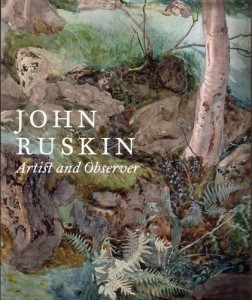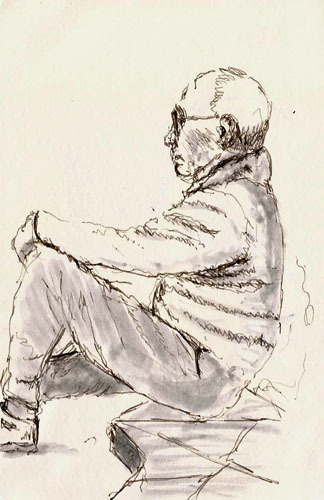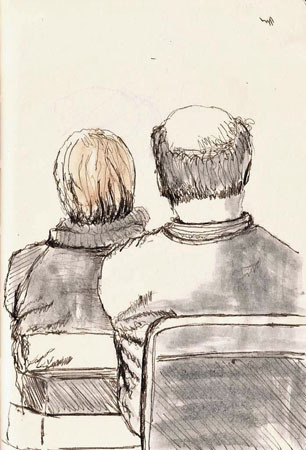Larry D. Marshall's Blog, page 91
March 29, 2014
Winter Plods Along… Forever
Didn’t the weather-makers get the memo? It was declared spring on March 20th, ten days ago. Yesterday I was running my snowblower around in response to a snow storm. Predictions are for another six inches tomorrow. When is this going to end?
 I’m getting mighty frustrated that I can be out sketching. So much so that I sat in my office yesterday and drew rocks, probably channelling a mix of the many rock photos and paintings I’ve seen (9×6). Very different for me but it calmed my frustrations a little bit. A very little bit. Please make it stop!!!
I’m getting mighty frustrated that I can be out sketching. So much so that I sat in my office yesterday and drew rocks, probably channelling a mix of the many rock photos and paintings I’ve seen (9×6). Very different for me but it calmed my frustrations a little bit. A very little bit. Please make it stop!!!
March 28, 2014
Juliette Aristides Drawing Atelier
As a guy who has only been drawing for a couple years, I’ve noticed some things about the art world. First, and foremost is that many so-called “fine arts” schools have largely abandoned notions of realism in art and many have abandoned drawing as a base skill. Those who draw are directed to graphic design and/or animation departments. While this surprised me, I was a hobbyist and what happened in art school didn’t, I thought, affect me much.
And so I did what most hobbyist artists do. I bought lots of books on drawing and watercolors and I’ve tried to learn some of what was contained within them. If one buys enough of these you know that many present a series of “lessons” where the first sentence is something like “We first start with a sketch.” The lesson goes on to teach whatever aspect the lesson is meant to cover. How one gets the ‘sketch’ is left to the reader to figure out. I relied upon hobbyist ‘drawing’ books to learn what I could about that process.
Then I met my buddy and mentor, Yvan Breton. He is an architect and an accomplished artist. He started teaching me concepts like scaffolding, multiple plane thinking, use of the terminator, line thickness variation and other concepts that I had not seen discussed in the drawing books I’d read. He showed me how Rembrandt used these concepts in his art.
Initially I was reluctant to ‘add’ to what I was doing as a street sketcher, believing these ‘extra’ things would only add time to the process. Oh, how wrong I was. I’m still working to incorporate these ideas into my own sketches but as I do, my sketches have become better and my drawings are done more quickly and with better unity. I still need much practice but I’m beginning to see why it is that good artists are, well, good artists. More perplexing to me was why, if all the masters, like Monet, Renoir, Rembrandt, Raphael, etc. knew about these things, did I see so little evidence of the concepts in my drawing books.
 This led me back to the abandonment of traditional methodologies by fine art programs, which led me, in turn, to the “atelier movement” which seems to be taking place around the world. Small(ish) art schools, independent of universities, that are teaching what are called “foundational” art skills. I have no first-hand information of these schools except that they sound like the old apprenticeship programs that existed in the woodworking world.
This led me back to the abandonment of traditional methodologies by fine art programs, which led me, in turn, to the “atelier movement” which seems to be taking place around the world. Small(ish) art schools, independent of universities, that are teaching what are called “foundational” art skills. I have no first-hand information of these schools except that they sound like the old apprenticeship programs that existed in the woodworking world.
These ateliers make no bones about the fact that they are teaching what they teach because only by knowledge of these principles and methods can an artist have the tools to produce art. They quite explicitly argue that the singular emphasis on ‘imagination’ by art schools is akin to teaching students to have the imagination of Jules Verne but not the technical expertise of a rocket scientist and then expecting the student to go to the moon. Only by mastering foundational art skills, they say, will an artist have the freedom to succeed as an artist.
 From these discussions I found myself looking for books that cover those foundational skills and I got lucky to find Juliette Aristides, who started a ‘classical’ atelier. More important, she has written three outstanding books on the subject, the first of which is Classical Drawing Atelier, followed by Lessons in Classical Drawing. Her third book is something of a parallel that deals with painting. These two basic books, however, contain more information in them about drawing than ALL of the hobbyist drawing books I own. Rather than the typical piecemeal “here is perspective”, “here is foreshortening”, “here is tone”, she presents drawing as an integrative process. The second book, is more than just a series of lessons about what is in the first book. Rather it is an extension of the first book and the two work in concert to teach you to draw the way the greats did it. And you know what? It’s a LOT easier to deal with things like perspective, foreshortening, and composition if you view them as a whole than by viewing them as separate issues. This is why the drawings of good artists seems so much more unified than those of most of us.
From these discussions I found myself looking for books that cover those foundational skills and I got lucky to find Juliette Aristides, who started a ‘classical’ atelier. More important, she has written three outstanding books on the subject, the first of which is Classical Drawing Atelier, followed by Lessons in Classical Drawing. Her third book is something of a parallel that deals with painting. These two basic books, however, contain more information in them about drawing than ALL of the hobbyist drawing books I own. Rather than the typical piecemeal “here is perspective”, “here is foreshortening”, “here is tone”, she presents drawing as an integrative process. The second book, is more than just a series of lessons about what is in the first book. Rather it is an extension of the first book and the two work in concert to teach you to draw the way the greats did it. And you know what? It’s a LOT easier to deal with things like perspective, foreshortening, and composition if you view them as a whole than by viewing them as separate issues. This is why the drawings of good artists seems so much more unified than those of most of us.
In addition to the books, the second book comes with a instruction DVD where Aristides walks you through the development of four separate drawings. I’ve only watched it twice thus far but I’ve found it, like the books, to be invaluable. I should mention that while the book covers suggest these books are about life drawing, they are not exclusive to it. In the DVD, for instance, Aristides uses an old pair of boots as one of its subjects, a large pitcher as another. The techniques can be applied to and will improve any drawing. If you’ve been drawing for a while and woud like to improve, give these books a try as unless you’re already an accomplished artist, some practice of these methodogies will not only improve your drawings, it will make them easier to do.
March 26, 2014
Faber-Castell Perfect Pencil
I have to confess up front that I’m not a pencil guy. I might even want to be but I enjoy pushing pens across paper so much that it’s hard for me to use anything else. And so I carry a single 0.5mm mechanical pencil with 2H or 3H lead that I use to quickly block in a subject before I start drawing it. As I said…I’m not a pencil guy.
 So it’s odd for me to be talking about a pencil but Faber-Castell’s Perfect Pencil snapped my head around when I heard about it and double-snapped it when I found one in an Ottawa art supply store last weekend. It’s just plain cool, even if it is a pencil.
So it’s odd for me to be talking about a pencil but Faber-Castell’s Perfect Pencil snapped my head around when I heard about it and double-snapped it when I found one in an Ottawa art supply store last weekend. It’s just plain cool, even if it is a pencil.
I also have to confess that I love wooden pencils. They just feel good in my hand. I also like that you can use the side of them, use them dull, or sharpen them up for fine details.
I don’t use them, though, for a couple reasons, mostly stemming from the fact that I do my drawing on the run as a street sketcher. This, for me, makes (or made) wooden pencils impractical. Here’s why:
1) You have to sharpen them and the tiny portable pencil sharpeners produce a short, stubby tip. Yes, I can use my pen knife, which is very Bohemian, but also rather impractical when sitting in a music recital or riding a bus.
2) The tips break unless protected. Yes, I can keep them in a case but then they’re not available. A lot of my sketching is ‘grab the book and draw’ sorts of sketching.
3) The length becomes a problem as the pencil is used. And yes, I could buy an extender. Something else to carry.
What makes the Perfect Pencil so perfect is that it solves all THREE of these problems. The Perfect Pencil comes with a sharpener, and not just any sharpener. It’s a sharpener that produces a nice, long and sharp tip. The Perfect Pencil has a cover for the pencil tip, a cover that has a clip just like my fountain pens so it’s easy to carry. And when the pencil becomes short, you can stick its rear end into the cap, which acts as an extender. Best of all, you get all this for the price of one of those high-priced coffees where you get to feel empowered while making all those mind-bending choices.
 I can’t say much about the pencil that comes with the Perfect Pencil. It seems like a Faber-Castell HB pencil but it’s round rather than hexagonal. That said, you can replace it with any standard-size pencil. I’ve tried other Faber-Castell pencils (including watercolor pencils), Staedtler pencils, and Blackwing 602s. The 602s defeat the extender function because of their square eraser but otherwise they work fine. I might become a pencil guy yet. In any case, I’ll be carrying my Perfect Pencil when you see me on the street.
I can’t say much about the pencil that comes with the Perfect Pencil. It seems like a Faber-Castell HB pencil but it’s round rather than hexagonal. That said, you can replace it with any standard-size pencil. I’ve tried other Faber-Castell pencils (including watercolor pencils), Staedtler pencils, and Blackwing 602s. The 602s defeat the extender function because of their square eraser but otherwise they work fine. I might become a pencil guy yet. In any case, I’ll be carrying my Perfect Pencil when you see me on the street.
March 22, 2014
Visiting The John Ruskin Exhibition
“The greatest thing a human soul ever does in this world is to see something, and tell what it saw in a plain way. Hundreds of people can talk for one who can think, but thousands think for one who can see.” – John Ruskin (Modern Painters vIII, 1856).
John Ruskin was a reknowned art critic, outspoken advocate for art that reflected nature, a proponent of hand-craftsmanship in the face of the industrial age, a curmudgeon, a prolific writer, and by many accounts, something of a mental case. I ignore this last attribute of his character as it’s a facet of his life that approximates my own.
Well, there is another. Ruskin never considered himself an “artist.” He was in the business, he said, of creating “documentation”, often of nature but also of architecture that he was, at times, fighting to preserve.

National Gallery of Canada
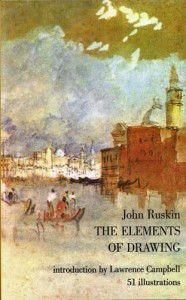 And by some luck and good fortune I had a very good excuse to get myself to Ottawa to see the exhibition of 140 examples of “documentation” created by his hand. It was a mind-bending experience to see what Ruskin could do with pen and ink, though I don’t want to short-change his watercolor/gouache works a bit. The exhibit runs through May 2014 and if you can, I recommend it to anyone who lifts a pointy device and puts it to paper. More info is available at their website here. Words cannot begin to describe Ruskin’s art so I won’t even try.
And by some luck and good fortune I had a very good excuse to get myself to Ottawa to see the exhibition of 140 examples of “documentation” created by his hand. It was a mind-bending experience to see what Ruskin could do with pen and ink, though I don’t want to short-change his watercolor/gouache works a bit. The exhibit runs through May 2014 and if you can, I recommend it to anyone who lifts a pointy device and puts it to paper. More info is available at their website here. Words cannot begin to describe Ruskin’s art so I won’t even try.
If you are someone who draws, and haven’t already done so, Ruskin’s book, Elements of Drawing is an excellent text – better than most in my opinion.
And my new prized possession is this volume – a compilation of the exhibition drawings/paintings with historical commentary associated with each one. It is prefaced by what appear to be substantive essays on Ruskin, his influences, and those he influenced. I wish I could say that I have read them but I just got back from Ottawa a few hours ago (grin).
March 19, 2014
Give Me A Hand And….
…I’ll draw it. Particularly if it’s a plaster cast of a hand.

Canson Ingres toned paper, Pilot Prera, Noodler’s Lexington Gray ink
I’m so excited!!! Hidden away, in the bowels of the Université Laval music building is a museum of sorts. Sadly, it’s not a museum you can visit. It’s a place where the entire collection from the now defunct natural history museum is stored. In addition, Madame Wagner, the curator, has stored a very large collection of plaster casts that were cast off by the art department when it was decided that learning to draw wasn’t quite as important as it once was. Abstract art, it seems, has had a very debilitating long-term affect on the art community 
So imagine a place where you can walk among stuffed water buffalos, bears, mountain sheep and caribou. Imagine cabinet after cabinet of avian, insect, marine, and mammal fauna, all just waiting to be drawn. Imagine another room full of artifacts from all parts of the earth and some from outer space. Imagine walls lined with plaster busts, full statues, and other plaster body parts. Would you like to sketch there?
Me too. And just to sweeten the pot, imagine that in one corner of this place is a makeshift studio where one can take any item, set it up on a stage, light it, and then sit in a very quiet room while drawing for as long as you like? Pretty sweet picture, isn’t it?
But, for me, there’s more cuz my friend Yvan has access to this place and I’ve been invited to join him. Suddenly I don’t care as much about our ridiculously cold temperatures and I’m hoping to spend at least one morning a week in this wonderful dream world. Today, following a tour, I grabbed a hand and did the small drawing above. I need to get better at shading with pen but it was sure fun.
March 17, 2014
Mo Music, S’il Vous Plait!
We’re back in the deep freeze here in Quebec. Will it never end? But we’re also in the middle of recital season, a time when the students at Conservatoire de Musique give recitals and what a joy they are to attend. Today it was pianists…amazing pianists. Marie Robitaille, Sophie Doyon, Brigitte Legendre, Bruce Gaulin-Boilard, Manuella Gagnon, Corolane Tremblay, and Ariane Filion-Thériault each graced us with their musical prowess.

Stillman & Birn Alpha (4×6); Pilot Prera, Noodler’s Lexington Gray ink
And while they did, Yvan and I sketched, though I have to admit that at times I just stopped, listened and watched magical hands on keys. But here are a couple sketches I did during the nearly two hours of music. Thanks to the Conservatoire, the students, and Suzanne Beaubien-Lowe (their teacher) for making a very cold day seem just a little bit warmer.

Stillman & Birn Alpha (4×6); Pilot Prera, Noodler’s Lexington Gray ink
March 15, 2014
If Only I Had Time To Sketch…
If you sketch in the presence of others you’ll hear it. It comes in many forms but, if you get down to the bone of what’s being said it’s “If only I had time to sketch like you do” and it’s said as though my daily 24-hour time allotment is longer than their 24-hour allotment. Or maybe they’re really talking to themselves, excusing themselves in some twisted way.
I’m not sure what it is but I never know what to say. The truth is, we all have the same amount of time per day. Yes, some have to work more hours than others. Some have kids. Some are in school. In spite of this, the average American, it is said, manages to watch four to five hours of television every day. Facebook and Twitter traffic suggest that the hours spent in front of computer aren’t insignificant either. Sooo…..whether you believe it or not, discretionary time is something we ALL have available to us. It’s how you spend it that determines whether you do or do not have time for sketching.
The truth is, it doesn’t take much time to be a sketcher. It’s true that I do spend time with sketching friends and that I often wandering the streets, enjoying extended sketching sessions on occasion. But I’ve been “very busy” for the last few days and so haven’t done any “serious” sketching. In spite of that, I have sketched and I’ve had fun sketching. I thought I’d show you a few of the smallish sketches I’ve done, providing a bit of context in an attempt to demonstrate just how easy it is to include sketching in your day.

Done in Stillman & Birn Alpha (4×6), Hero 9018 and Diamine Chocolate Brown ink
The single thing that is required to be a sketcher is to be READY to sketch, which means you have paper and pointy device with you at all times. If my sketching were limited to finding special blocks of time to set up my art materials, I wouldn’t do 2/3 of the sketches I do. As the Boy Scout motto says, “Be Prepared.” It’s also important to think about enjoying the process of drawing, not creating great art. Sketching is about the fun – about the doing – or it should be. If you’ve got to find that ‘perfect’ scene, you’ll never sketch.
Here’s a sketch I did while I was at the library. It took only a few minutes. Libraries are target-rich environments and one of the few places where humans sit still for a while.

3×5 cheap notebook, Pitt brush pen
I stopped by the art store and picked up some Pitt brush pens, followed by a stop for coffee. It seemed as good a time as any to try out one of the new pens. This rooftop sketch was done in my el cheapo ($1.25 at the dollar store) notebook between sips of coffee and increased the enjoyment of that pause in the day.

Canson Ingres paper (3×5); Pilot 78G, Platinum Carbon Sepia & a bit of Lex Gray added with a Pilot Prera
I’d been at the art museum and if you look out their front window you see a monument to General Wolfe, the guy who died winning the battle for Quebec City back in 1759. Behind it is a street lined with buildings.
That night, I was watching American Idol with Chantal and I was bored, so I picked up a pen and a 3×5 piece of Canson Ingres paper (I have these materials available at my TV watching perch) and drew the scene from memory. It only took a few minutes but it was a pleasant experience and I emphasized the use of loose, light pen strokes.

3×5 cheap notebook; Platinum Carbon pen w/Platinum Carbon Black ink
At another time I was watching a Toronto Blue Jays pre-season game and drew this group of flowers. That are part of a larger, dried flower arrangement in our living room. Used a Platinum Carbon pen for this one.
Are these great drawings? Nope…but they were fun. Did they take a long time? Nope. In fact no ‘extra’ time was required at all. I just counted and from Sunday to Friday, when I’ve been ‘too busy to draw,’ I’ve done more than a dozen sketches, all in ‘spare’ time. The only exception was my attendance at a music recital that I would have gone to with or without sketching. It doesn’t take much time to be a sketcher. You DO have time… don’t you?
March 9, 2014
First Outdoor Sketch of “Spring???”
I was heading downtown the other day, marching along ice-covered sidewalks and hopping over occasional mounds of snow when it occurred to me – it was pretty “warm.”
Now you’ve got to understand what the word means in early March in Quebec City. It means I was walking briskly, wearing a sweater over a long-sleeve shirt and with a heavy coat on top of that. It was “warm.” The temperature had risen all the way to -5C (22F).
And possibly a result of my being a street sketcher harboring a desperation brought on by a long winter, I made a decision. Rather than go to the coffee shop, or to the library, as I was planning, I would head to Place D’Youville (a central location inside our old, walled city) and sketch something OUTDOORS!!!
And it all started great. When I arrived there were a bunch of ice skaters waiting for the Zamboni to clean off the ice rink. I took a position among them on one of the benchs, got out my Stillman & Birn Alpha (4×6) and my Hero 578. I wasn’t completely delusional about the definition of “warm” so I decided this would be a sketch done quickly.
By the time I got to thinking about adding some details, the notion of “warm” had long since disappeared, as had my ability to feel the pen in my hands. My brain had shifted from “get it right” to “get it done” and I was quickly bringing the sketch to a close. I packed up and headed for the McDonalds on St. Jean Street.
 After huddling over a cup of coffee for warmth, I decided to add some color and got the bright idea to “boldly go where Larry had not gone before” and play with mixing color on the paper and I capped this off with a bit of splatter. While I had no idea what I was doing, there was a serendipity about the process that was fun.
After huddling over a cup of coffee for warmth, I decided to add some color and got the bright idea to “boldly go where Larry had not gone before” and play with mixing color on the paper and I capped this off with a bit of splatter. While I had no idea what I was doing, there was a serendipity about the process that was fun.
 Because McDonalds was very busy, they’d opened up their third-floor eating area so I headed there, hoping to get a different look at the rooftops. Unfortunately, there were big posters covering most of the windows so the view was limited. But, by ducking down and shifting forward a bit, I could see under an ad for something called a McWrap and I could see the steeple of a small church next to the downtown hospital (founded in 1639). It stuck up behind a pile of metal thingies on top of the building in front of it. Same sketchbook here but I used my Pilot Prera on this one.
Because McDonalds was very busy, they’d opened up their third-floor eating area so I headed there, hoping to get a different look at the rooftops. Unfortunately, there were big posters covering most of the windows so the view was limited. But, by ducking down and shifting forward a bit, I could see under an ad for something called a McWrap and I could see the steeple of a small church next to the downtown hospital (founded in 1639). It stuck up behind a pile of metal thingies on top of the building in front of it. Same sketchbook here but I used my Pilot Prera on this one.
While it wasn’t as “warm” as I thought, it was a great day and, as they say, I broke the ice on 2014 outdoor sketching… almost literally.
March 7, 2014
Shading Quick-Sketches Quickly
Many sketchers enjoy doing quick-sketches as they can be done while waiting in line, sitting in a doctor’s reception room, or in any food court. You can do them while driving down the highway, though it’s best to have someone else driving. I fill several sketchbooks a year with these kinds of sketches, each taking 1-3 minutes.
But one thing these simple line drawings lack is any sense of tonal variation – unless you add it. As a couple people have asked about how I do it I thought I’d talk about my process, though I’m a rank amateur at quick-sketching. The same technique can be used to color more complete drawings as well.
The most common form of shading quick sketches is to use an ink that isn’t waterproof. Most fountain pen inks are not so you have a wide range of colors, brands, and pens to choose from. I believe Goulet Pens say they stock 600 inks, and most of them are water-soluble.
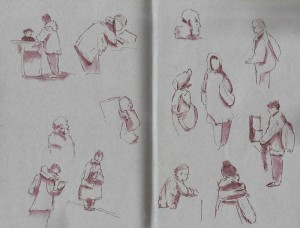
Done in Strathmore “toned gray” sketchbook, using J.Herbin 1670 ink. Click to enlarge.
If you carry a waterbrush (with clear water), shading with water-soluble ink is easy. You simply run the pen along one side of the line, pulling color from the line and into a shape to indicate shading.
While this is, by far, the easiest approach there are a couple of potential drawbacks. First, drawing ink away from the lines diminishs the lines and possibly makes them fuzzy. This can be good or bad, of course. The other limitation is that your shading is the same color as the lines. Again, sometimes good, sometimes bad.

Stillman & Birn Alpha, Noodler’s Lex Gray and brown & black waterbrushes. Click to enlarge.
For nearly a year, now, in addition to a clear-water waterbrush I’ve carried a waterbrush where I’ve added a few drops of Noodler’s Lexington Gray and another with a few drops of Noodler’s Polar Brown. This gives me the flexibility to use both a brown and a gray to shade my drawings and I can do it in seconds. I keep the shade from the waterbrush very light so that I can apply multiple coats and obtain a range of colors. I think the very dilute solution helps keep the brushes flowing properly. I use a waterproof ink (Noodler’s Lexington Gray) for the linework so that it’s unaffected by the shading.
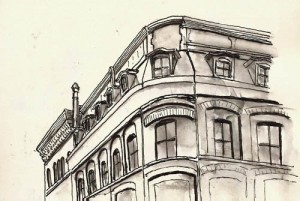
Stillman & Birn Alpha 4×6. Pilot Prera & gray waterbrush. Click to enlarge
If you enjoy quick-sketching, give this approach a try. Easy to carry, easy to apply when there’s no time for a full watercolor treatment.

Some quickies at the coffee shop. Click to enlarge.

Using both color sometimes enhances the scene. Click to enlarge.
March 5, 2014
Music For Nothing And Your Sketching For Free
Apologies to Dire Straits for the title of this post. When MTV came along, Dire Straits did an animated video to their award-winning song Money For Nothing (and your chicks for free). The song was great and the video hilarious. Almost got me to watch MTV. Now that I’m in Canada, however, I’m not allowed to see it because the song has a couple words in it that caused it to be banned by a hyper-conservative Canadian media police.
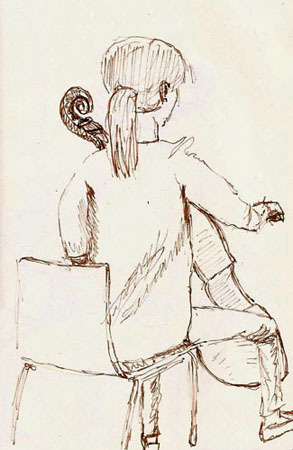
Pilot Prera, Platinum Sepia
The title of this post pretty well describes my week. I’ve heard some pretty spectacular music and I did some sketching at each of the events. I’ve already reported on the special musical sketching event last weekend and on Thursday I was at the art museum for a recital that included a bassoon/piano piece and several pieces for bass and piano.
On Saturday I attended what may have been the cello equivalent of a sketchcrawl, as a bunch of very skilled cellists met at the conservatory to play together, pass on trade secrets and enjoy one another’s company.  Remember the show Fame, where the dancers and musicians would dance/play in the lunch room? That’s how it was at the cello-fest. Imagine eating lunch to cello music. One person or group would finish and another would take their seats. It was amazing! Much better than my sketches, by the way.
Remember the show Fame, where the dancers and musicians would dance/play in the lunch room? That’s how it was at the cello-fest. Imagine eating lunch to cello music. One person or group would finish and another would take their seats. It was amazing! Much better than my sketches, by the way.
And then on Sunday I was at Le Grand Theatre to listen to Litania Projekt, a fantastic Montreal jazz quartet (bass, piano, drums and trumpet).

Prismacolor 005, purple, Strathmore ‘toned gray’ sketchbook
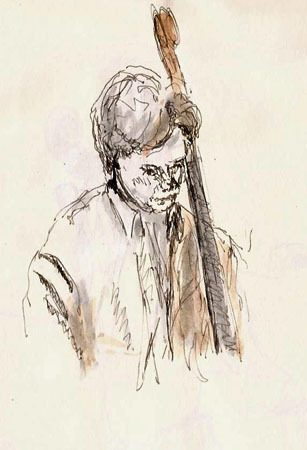 And the best part is that all of these concerts were FREE!!! I love Quebec. Lots of sketching was committed while listening. I’ll only bore you with a few of them.
And the best part is that all of these concerts were FREE!!! I love Quebec. Lots of sketching was committed while listening. I’ll only bore you with a few of them.

